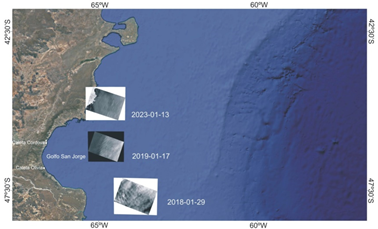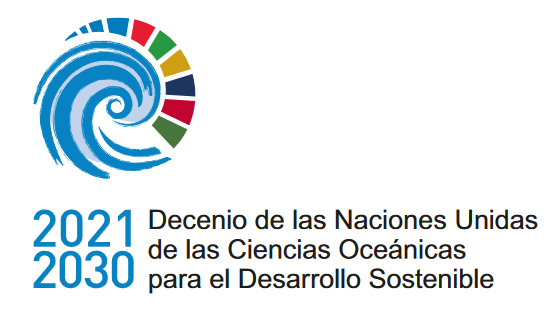Filtraciones de petróleo desde la plataforma patagónica: su destino termoestérico
DOI:
https://doi.org/10.47193/mafis.3712024010102Palabras clave:
Imágenes SAR, plataforma continental, ArgentinaResumen
Las imágenes de radar se aplican comúnmente para reconocer y monitorear las filtraciones de petróleo en las aguas superficiales sobre las plataformas continentales. En el Golfo San Jorge, Patagonia, entre los 46° S y 48° S, se han relevado manchas de petróleo que presentan patrones de elipse en respuesta a la dinámica mesotidal. Estos efectos fueron asignados a incrementos episódicos recientes de las temperaturas del fondo del verano a profundidades entre 100 y 120 m, que son 2 °C más cálidas que las registradas durante el siglo XX. Se supone que las manchas tienen su origen en fallas ya conocidas por la industria petrolera en tierra. Los efectos aquí descritos deben contemplarse en un escenario de cambio climático que provoque un aumento de la temperatura de las aguas poco profundas de los océanos, junto con otros efectos como el aumento global del nivel del mar inducido por el hombre. Bajo tales condiciones más cálidas, las filtraciones de los suelos de la plataforma continental serán más frecuentes y su contribución al balance de C atmosférico debe evaluarse globalmente.
Descargas
Métricas
Citas
Abraham JP, Baringer, M, Bindoff, NL, Boyer, T, Cheng, LJ, Church, JA, Conroy, JL, Dominguez, CM, Fasullo, JT, Gilson, J, et al. 2013. A review of global ocean temperature observations: implications for ocean heat content estimates and climate change. Rev Geophys. 51: 450-483. DOI: https://doi.org/10.1002/rog.20022
Asl SD, Dukhoovskoy DS, Bourassa M, MacDonald IR. 2017. Hindcast modeling of oil slick persistence from natural seeps. Remote Sens Environ. 189: 96-107.
Baldoni A, Molinari G, Guerrero RA, Kruk M. 2008. Base regional de datos oceanográficos (BaRDO) INIDEP. Inf Invest INIDEP Nº 13/2008. 25 p.
Chidichimo MP, Martos P, Allega L, Berghoff C, Bianchi AA, Cozzolino E, Dogliotti AI, Dragani WC, Fenco H, Fiore M, et al. 2022. Cambios físicos y geoquímicos en el Océano Atlántico Sudoccidental. In: Buratti CC, Chidichimo MP, Cortés F, Gaviola S, Martos P, Prosdocimi L, Seitune D, Verón E, editors. Estado del conocimiento de los efectos del cambio climático en el Océano Atlántico Sudoccidental sobre los recursos pesqueros y sus implicancias para el manejo sostenible. Buenos Aires: Ministerio de Agricultura, Ganadería y Pesca. p. 27-81.
CGG GeoConsulting. 2019. NPA satellite mapping-oil exploration; Argentina 2018 seepage study. [accessed 2023 Apr]. https://satelliteblog.cgg.com/seeps-confirm-potential-for-offshore-argentina/.
Commendatore MG, Esteves JL, Colombo JC. 2000. Hydrocarbons in coastal sediments of Patagonia, Argentina: levels and probable sources. Mar Pollut Bull. (40) 11: 989-998.
Desiage PA, Montero-Serrano JC, St-Onge G, Crespi-Abril AC, Giarratano E, Gil MN, Haller MJ. 2018. Quantifying sources and transport pathways of surface sediments in the Gulf of San Jorge, central Patagonia (Argentina). Oceanography. 31 (4): 92-103. DOI: https://doi.org/10.5670/oceanog.2018.401
Desiage PA, St-Onge G, Duchesne MJ, Montero-Serrano JC, Haller MJ. 2023. Late Pleistocene and Holocene transgression inferred from the sediments of the Gulf of San Jorge, central Patagonia, Argentina. J Quat Sci. 38 (5): 629-646. DOI: https://doi.org/10.1002/jqs.3511
Figari E, Strelkov E, Laffitte G, Cid de La Paz MS, Courtade S, Celaya J, Vottero A, Lafourcade P, Martínez R, Villar H. 1999. Los sistemas petroleros de la Cuenca del Golfo San Jorge: síntesis estructural, estratigráfica y geoquímica. IV Congreso de Exploración y desarrollo de hidrocarburos. Actas IV Congreso de Exploración y Desarrollo de Hidrocarburos: Mar del Plata, Argentina, 18 al 21 de abril de 1999. Buenos Aires: Instituto Argentino del Petróleo y del Gas. p. 197-237.
Foix N, Paredes JM, Giacosa RE. 2008. Paleo-earthquakes in passive-margin settings, an example from the Paleocene of the Golfo San Jorge Basin, Argentina. Sediment Geol. 205: 67-78.
Idier D, Paris F, Le Cozannet G, Boulahya F, Dumas F. 2017. Sea-level rise impacts on the tides of the European Shelf. Cont Shelf Res. 137: 56-71.
Isla, FI, Iantanos N, Estrada, E. 2002. Playas reflectivas y disipativas macromareales del Golfo San Jorge. AAS Revista. 9 (2): 155-164.
[ITOPF] The International Tanker Owners Pollution Federation Limited. 2022. Oil tanker spill statistics 2021. London: ITOPF. 18 p. [accessed 2023 Apr]. https://www.itopf.org/knowledge-resources/data-statistics/statistics/.
Jafarzadeh H, Mahdianpari M, Homayouni S, Mohammadimanesh F, Dabboor M. 2021. Oil spill detection from synthetic aperture radar earth observations: a meta-analysis and comprehensive review. GISci Remote Sens. 58 (7): 1022-1051. DOI: https://doi.org/10.1080/15481603.2021.1952542
Jatiault R, Dhont D, Loncke L, Dubucq D. 2017. Monitoring of natural oil seepage in the Lower Congo Basin using SAR observations. Remote Sens Environ. 191: 258-272.
Klotz P, Schloss IR, Dumont D. 2018. Effects of a chronic oil spill on the planktonic system in San Jorge Gulf, Argentina: a one-vertical-dimension modeling approach. Oceanography. 31 (4): 81-91. DOI: https://doi.org/10.5670/oceanog.2018.413
Kluser S, Richard JP, Giuliani G, De Bono A, Peduzzi P. 2006. Illegal oil discharge in European seas. Environment Alert Bulletin. 7. Geneva: UNEP/DEWA-Europe/GRID. 4 p. https://unepgrid.ch/storage/app/media/legacy/23/ew_oildischarge.en.pdf.
Kvenvolden KA, Cooper CK. 2003. Natural seepage of crude oil into the marine environment. Geo Mar Let. 23: 140-146.
Kvenvolden KA, Rogers BW. 2005. Gaia’s breath-global methane exhalations. Mar Pet Geol. 22: 579-590.
Marghany M. 2014. Oil spill pollution automatic detection from MultiSAR satellite data using genetic algorithm. In: Marghany M, editor. Advanced geoscience remote sensing. INTECH. p. 51-71. DOI: http://doi.org/10.5772/58572
Marzialetti PA. 2012. Monitoreo de derrames de hidrocarburos en cuerpos de agua mediante técnicas de sensado remoto [thesis]. Córdoba: Universidad Nacional de Córdoba. 141 p.
Najoui Z, Riazanoff S, Deffontaines B, Xavier JP. 2018. Estimated location of the seafloor sources of marine natural oil seeps from sea surface outbreaks: a new “source path procedure” applied to the northern Gulf of Mexico. Mar Petrol Geol. 91: 190-201.
Nunziata F, Miglioccio M. 2015. Oil spill monitoring and damage assessment via PolSAR measurements. Aquatic Procedia. 3: 95-102.
Oppenheimer M, Glavovic BC, JHinkel J, van de Wal R, Magnan AK, Abd-Elgawad A, Cai R, Cifuentes-Jara M, De Conto RM, Ghosh T, et al. 2019. Sea level rise and implications for low-lying islands, coasts and communities. In: Pörtner H-O, Roberts DC, Masson-Delmotte V, Zhai P, Tignor M, Poloczanska E, Mintenbeck K, Alegría A, Nicolai M, Okem E, et al. editors. IPCC special report on the ocean and cryosphere in a changing climate. Cambridge University Press. p. 321-445.
Palma ED, Matano RP, Tonini MH, Martos P, Combes V. 2020. Dynamical analysis of the oceanic circulation in the Gulf of San Jorge, Argentina. J Mar Syst. 203: 103261.
Phrampus BJ, Hornbach MJ. 2012. Recent changes to the Gulf Stream causing widespread gas hydrate destabilization. Nature. 490: 7421.
Pickering MD, Horsburgh KJ, Blundell JR, Hirschi JJ, Nichols RJ, Verlaan M, Wells NC. 2017. The impact of future sea-level rise on the global tides. Cont Shelf Res. 142: 50-68.
Risaro DB, Chidichimo MP, Piola AR. 2022. Interannual variability and trends of sea surface temperature around southern South America. Front Mar Sci. 9: 829144.
Sylwan CQ. 2001. Geology of the Golfo San Jorge Basin, Argentina. J Iber Geol. 27: 123-157.
Wang Y, Chen D, Song Z. 2013. Detecting surface oil slick related to gas hydrate/petroleum on the ocean bed of South China Sea by ENVI/ASAR radar data. J Asian Earth Sci. 65: 21-26.

Descargas
Publicado
Cómo citar
Número
Sección
Licencia
Derechos de autor 2023 Federico I. Isla, Luis C. Cortizo

Esta obra está bajo una licencia internacional Creative Commons Atribución-NoComercial-CompartirIgual 4.0.
Los autores de los artículos publicados en Marine and Fishery Sciences conservan los derechos de autor de sus artículos, a excepción de las imágenes de terceros y otros materiales añadidos por Marine and Fishery Sciences, que están sujetos a los derechos de autor de sus respectivos propietarios. Por lo tanto, los autores son libres de difundir y volver a publicar sus artículos, sujeto a los requisitos de los propietarios de derechos de autor de terceros y sujeto a que la publicación original sea completamente citada. Los visitantes también pueden descargar y reenviar artículos sujetos a los requisitos de citas. La capacidad de copiar, descargar, reenviar o distribuir cualquier material siempre está sujeta a los avisos de derechos de autor que se muestran. Los avisos de copyright deben mostrarse de manera prominente y no pueden borrarse, eliminarse u ocultarse, total o parcialmente. El autoalmacenamiento en servidores y repositorios de preimpresión está permitido para todas las versiones.
Esta revista ofrece a los autores una política de acceso abierto. Los usuarios pueden leer, descargar, copiar, distribuir, imprimir, buscar o vincular los textos completos de los artículos, o usarlos para cualquier otro propósito legal dentro de la licencia Creative Commons 4.0 (BY-NC-SA), sin solicitar permiso previo del editor o del autor. Esto está de acuerdo con la definición BOAI de acceso abierto.



























